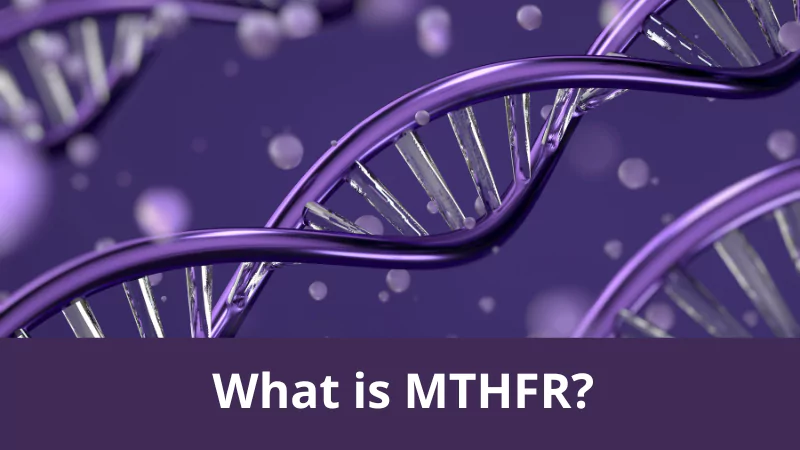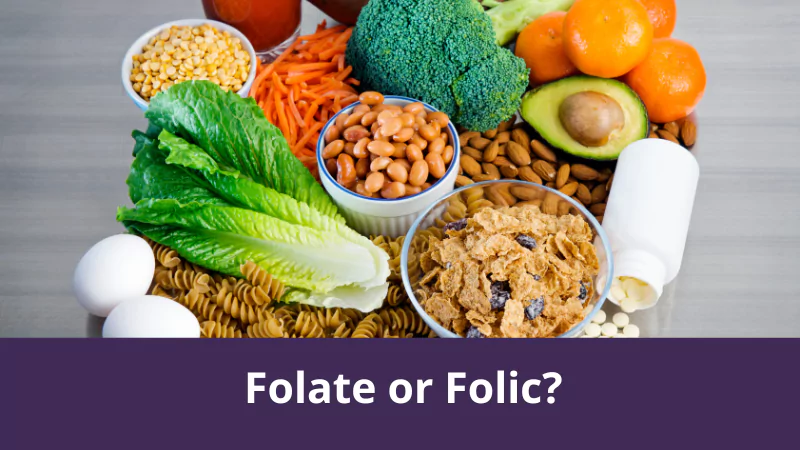The MTHFR gene is responsible for the production of its enzyme MTHFR, which stands for methylenetetrahydrofolate reductase.
The MTHFR enzyme converts folate, in the presence of cofactors, into the active form, 5-methyltetrahydrofolate, for it to be metabolized and used in various biochemical reactions within the human body. This is done through a process called methylation, which is a mechanism of activating certain molecules or mechanisms in the body through adding a methyl group to the target molecule that is required to be activated.
The activation of folate in the form of 5-methyltetrahydrofolate is essential for DNA synthesis, amino acid metabolism, detoxification, formation of blood cells and platelets, and single carbon metabolism. Therefore, we shall take a deeper look at folate metabolism, how the MTHFR gene is involved in folate metabolism, important concepts in the fields of genomics and epigenetics, and why we care about looking at our genes.
Folate metabolism
Folate, which is also known as vitamin B9, is required by the cell to ensure efficient nucleic acid synthesis and amino acid metabolism. It should not be confused with folic acid, which is a form of folate. However, folic acid is synthetic and cannot be converted into active folate unless the body has the capacity to do this.
The major process involved in this conversion is a methylation reaction. In some individuals, however, methylation might be affected by various biological and chemical factors. Mutations in the MTHFR gene, which is a major factor influencing methylation, can play a role in low folate levels. Low levels of folate can result in numerous metabolic defects, such as high levels of homocysteine, amino acid imbalances, and reduced formation of blood cells and platelets.
Folic acid, which is introduced into the cells through the consumption of fortified foods and supplements, is converted into several intermediates before it is converted into 5-MTHF. Folic acid is initially converted by DHFR into DHF (dietary folate), which is further metabolized to THF, 5,10-methylene-THF, and, eventually, folate. However, the DHFR enzyme is rapidly saturated, resulting in a buildup of folic acid. This may result in tumour-promoting effects, and a high risk of the development of infantile autism. This is why folic acid is not the best form of folate for those with the MTHFR gene mutation.
Dietary folate, however, is necessary for the regulation of good health- typically through consuming dark leafy greens, such as spinach, kale, turnip greens and romaine lettuce. The consumption of these foods provide an immediate increase in folate levels. Contrary to folic acid, folate found naturally in foods helps reduce the risk of many forms of cancer. Sufficient blood folate levels also assist in reducing the likelihood of suffering from depression. Therefore, naturally occurring folate is not harmful and thus essential in preventing and reducing folic acid buildup.
The pathway from THF to 5,10-methylene-THF is one where vitamins B6 and B12 both play key roles in folate metabolism. Serine and glycine metabolism within this pathway, along with the conversion of other amino acids, necessitates the presence of vitamin B6.
Vitamin B12, however, is needed to aid in the recycling of homocysteine through conversion to methionine. Since vitamin B12 is also required for the conversion of folate back to THF, this reaction is coupled to the conversion of homocysteine into methionine. In other words, the rate of one reaction affects the rate of the other. For instance, if too much methionine is produced, there will be a low concentration of vitamin B12, and hence less THF is converted from folate – therefore it will result in a higher concentration of folate. However, sufficient vitamin B12 levels are necessary to convert homocysteine into methionine. It is thus clear that there exists a delicate balance of metabolic intermediates and cofactors in the folate metabolic pathway.
Why is it important to look at our genes?
Our genes are not only essential in our understanding of what makes us, as individuals, unique, but also vital in determining the cause of any health-related issues such as genetic defects and metabolic disorders. Genes are responsible for encoding the production of proteins in the body. The production of proteins, and thus enzymes, is necessary for metabolic and other biochemical reactions to occur within the body. A lack of, an abundance of or mutation of one type of protein could result in a negative impact on your health. Mutations of the MTHFR enzyme is one example of irregular protein levels that may cause drastic effects to your health. Chronic fatigue, diabetes, cancer, autism, insomnia, depression, infertility, and cardiovascular disease are some of the conditions that may result from MTHFR mutations and effects on the methylation cycle.
Genomics and epigenetics
The fields of genomics and epigenetics are crucial to medical research. Genomics focuses on the sequencing of an organism’s DNA, whereas epigenetics is the study of changes related to gene expression, but not alteration. So in other words, we can’t do anything about our genes, but we may be able to affect the way they act. Both fields of study are important in the understanding of our genes and how they function in our bodies.
Take away Message
The MTHFR mutation may have far-reaching effects in some people, particularly if the environment has caused further expression. Everything from dysbiotic gut bacteria, diet, stress, exposure to environmental chemicals may disturb the methylation cycle further, thereby increasing the effect of an MTHFR mutation. It is important to remember, that just because there is a mutation, there may not be an issue for the patient. A thorough family history, assessment of gut function, stress, lifestyle and environmental/heavy metal toxin must be conducted.
Reference list
Locasale, J. (2013). Serine, glycine, and one-carbon units: cancer metabolism in full circle. Retrieved from http://www.nature.com/nrc/journal/v13/n8/fig_tab/nrc3557_F3.html
Joe. (2016). MTHFR mutation, symptoms and diet: What you need to know. Retrieved from https://www.dietvsdisease.org/mthfr-mutation-symptoms-and-diet/
National Institutes of Health. (2016). Folate. Retrieved from https://ods.od.nih.gov/factsheets/Folate-Consumer/#h7
Group, E. (2011). 15 Foods High in Folic Acid. Retrieved from http://www.globalhealingcenter.com/natural-health/folic-acid-foods/
[products ids=”7511,6707,6402″ columns=”3″ orderby=”rand”]









